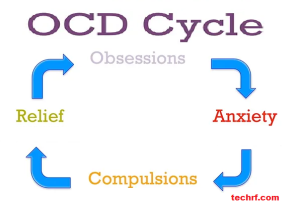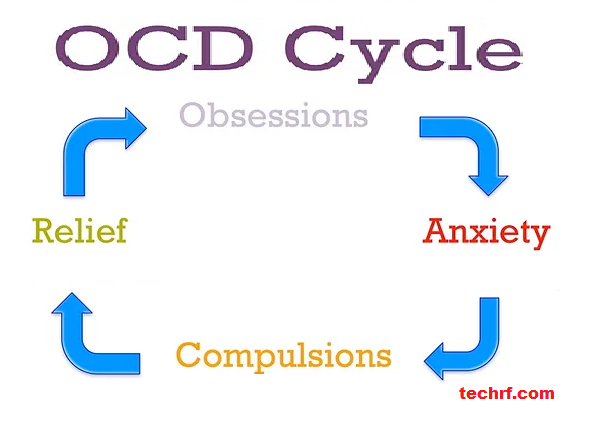OCD Life Cycle Chapter: It is normal to check that things are OK, safe or correct, probably several times a day. For most of us, one or two checks are enough to feel confident about the state of affairs and move on. However, people with control compulsions often get stuck in prolonged, repetitive, self-doubt-filled cycles of control.
Rachman (2002) introduced a characteristically simple and elegant model for understanding control compulsions. Two circumstances are necessary to control compulsions:
- First, people see themselves as personally responsible for preventing harm. and
- Second, they are not sure that their efforts have successfully removed the harm or reduced its probability to a tolerable level.
Three factors will differentiate the duration and intensity of control compulsion:
- Increased responsibility,
- Increased estimates of the probability of harm and
- Increased damage severity estimates.
These factors are not independent, so that estimates of harm increase with the extent to which the individual considers himself responsible for it, and responsibility for preventing that harm increases the more he controls. Thus, Rachman (2002) suggests that control persists due to self-perpetuating mechanisms.
There is considerable evidence for self-perpetuating mechanisms in control, particularly that the more a behavior is repeated, the less confidence one has in one’s subsequent memory of it. There is also very consistent and unshakable evidence that responsibility moderates anxiety about obsessions, the urge to act on a compulsion, and appraisals of the likelihood and severity of harm. There is also evidence that appraisals of harm severity and probability influence reassurance seeking (which Rachman calls “proxy control”).
To date, no study has examined the effect of the three modifiers of control behavior proposed by Rachman on the duration and intensity of control. The purpose of this study was to address this gap in the literature using an in vivo experiment (Radomsky et al, 2022).
How many times have you double-checked that you turned off the stove before leaving the house? People with control compulsions often get stuck in prolonged, repetitive, self-doubt-filled cycles of control.

Methods
Participants were 30 OCD individuals with clinically significant control concerns recruited from the community and 30 undergraduate students. The study was conducted in a laboratory kitchen equipped with a functional stove with four burners and a bank of 4 lamps connected to a power bar. Light bulbs represented a low failure severity (ie, if they were on when they were supposed to be off, the only damage would be wasted electricity) and stove burners represented a high failure severity (ie, if they stayed on when they were supposed to be off, could cause a fire). Harm probability was manipulated by asking participants to check the stove and lamps under two sets of circumstances. i) all lamps and burners were working.
Participants were also randomly assigned to high or low responsibility conditions. In the high-responsibility condition, participants were asked to sign a contract stating that they “assume full and complete responsibility for any damage, harm, or cost that may arise from their upcoming audits,” and were left alone in the kitchen for an audit. In the low liability condition, participants signed a contract stating that the researcher assumed all responsibility for damages and the researcher was present during the checks.
Thus, the study was a 2 (Group, OCD vs. control, between-participants factor) x 2 (Responsibility, high vs. low, between-participants factor) x 2 (impairment severity, low vs. high, within-participants factor) x 2 (harm probability, low vs. high, within-participant factor) mixed design.
Results
- As hypothesized, the OCD group passed more tests overall
- Both groups checked the stove more than they checked the lights, and both checked the working lamps/burners more than they checked the non-working ones
- However, there was no main effect of responsibility
- Both groups checked the stove more than the light bulbs, but the effect was stronger in the OCD group
- Finally, there was a three-way interaction between severity, probability, and group, such that the OCD group controlled even more than the nonclinical group under high severity and probability of harm.
Participants with OCD spent more time checking whether the stoves were safe than a control group of participants without OCD.
conclusions
The authors conclude that their findings are consistent with Rachman’s (2002) control model:
The results were mostly consistent with theory, showing that under conditions of increased severity and likelihood of harm, subjects engaged in more checking, especially those with a diagnosis of OCD who compulsively checked during their daily lives
Subjects checked more under conditions of increased severity and likelihood of harm.
Strengths and limitations
Unfortunately, the blame manipulation was not as effective as expected. That no main effect of responsibility was found is inconsistent with previous work, suggesting that the manipulation itself was somehow problematic. A number of analyzes in this study were underpowered, which complicates the interpretation of both positive and null findings. It is difficult to conduct research with people with OCD who also have specific symptoms, such as control, as the base rate in the population is low to begin with. However, the inclusion of people with OCD was also a strength of the study. The authors also note that although their goal was to create an ecologically valid paradigm.
Is controlling behaviors conducted in a lab kitchen really the same as controlling behaviors in a real kitchen?
Implications for practice
People with OCD who check, don’t check everything all the time. That is, they do not have a general deficit that produces control. Rather, this study contributes to a solid body of evidence that control occurs when important environmental factors are present, as Rachman (2002) argues. This highlights the critical importance of an idiosyncratic case composition that informs treatment. In particular, the findings have implications for exposure-based interventions and behavioral experiments, as neither is likely to achieve new learning if the relevant factors that activate the OCD system are absent.
People with OCD do not have a general deficit that causes control, but rather control occurs when important environmental factors are present. Therefore, interventions should focus on improving these contextual factors in real-world settings.
Declaration of interests
I have known Dr. Radomski for many years and consider him a close colleague. We collaborated on a paper in 2016.
Live at #BABCP2022 on 21 July 2022
Prof. Adam Radomsky (the lead author of this paper) will talk about this research in the #BABCP2022 keynote at 4-5pm. on Thursday 21 July 2022. Follow social media coverage on Twitter using the hashtag #BABCP2022 . Mental Elf will be live tweeting from London!
Listen to the #BABCP2022 podcast
Speaking ahead of their keynote addresses at the 2022 BABCP Annual Conference, Roz Shafran and Adam Radomsky talk about OCD, control, doubt, perfectionism and CBT.
